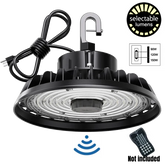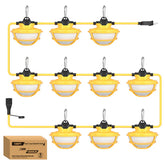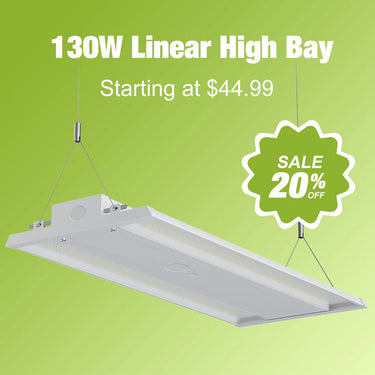How to Choose the Right High Bay Lights for Your Facility?
by
NioJaydon
29 Aug 2025
Selecting the right high bay lights isn’t a one-size-fits-all decision—whether you’re outfitting a warehouse, manufacturing plant, gymnasium, or retail distribution center, the wrong choice can lead to poor visibility, wasted energy, and costly maintenance. High bay lights are designed for spaces with ceilings 20 feet or higher, but their performance depends on aligning their features with your facility’s unique needs. Below is a step-by-step guide to help you make an informed choice, ensuring your lighting is efficient, safe, and tailored to your operations.

1. Start by Assessing Your Facility’s Core Needs
Before diving into technical specs, clarify the “why” behind your lighting upgrade or installation. Ask these key questions to narrow down your priorities:
What Type of Facility Are You Lighting?
Different spaces have distinct lighting demands:
- Warehouses/Distribution Centers: Prioritize uniform brightness for order picking, inventory checks, and forklift safety. Avoid dark spots between shelving or near loading docks.
- Manufacturing Plants: Need high color accuracy (to spot defects) and resistance to dust, moisture, or chemicals. Lighting should also withstand vibration from machinery.
- Gymnasiums/Sports Halls: Require glare-free light to avoid interfering with athletes or spectators, plus wide coverage for large open areas.
- Retail/Exhibition Spaces: Focus on color rendering (to make products look vibrant) and adjustable brightness for different displays or events.
What Are Your Key Goals?
- Energy Savings: If reducing utility bills is top priority, LED high bays are non-negotiable (they use 50–70% less energy than metal halide).
- Low Maintenance: Opt for fixtures with a lifespan of 50,000+ hours (LEDs) to avoid frequent bulb replacements in hard-to-reach high ceilings.
- Safety Compliance: Ensure lighting meets industry standards (e.g., OSHA requires 5–10 foot-candles for warehouses, 20+ for precision manufacturing).
2. Match Fixture Type to Your Space Layout
High bay lights come in three main designs, each suited to specific facility layouts. Choosing the right style ensures optimal light distribution:
1. UFO High Bay Lights
- Design: Compact, round shape (resembling a UFO) with a wide, diffused beam.
- Best For: Open spaces with few obstacles, such as large warehouses, gymnasiums, or aircraft hangars.
- Advantages: Easy to install (ceiling-mounted or suspended), provides uniform coverage across wide areas, and often includes built-in heat sinks for durability.
2. Linear High Bay Lights
- Design: Long, narrow fixtures (similar to fluorescent tubes but more robust) with directional beams.
- Best For: Spaces with aisles, shelving, or conveyor belts (e.g., retail distribution centers, manufacturing lines).
- Advantages: Can be mounted along aisles to direct light precisely onto work surfaces (e.g., picking shelves), reducing wasted light and improving visibility in tight zones.
3. Low Bay Lights (For “Borderline” Ceilings)
- Note: If your facility has ceilings 12–20 feet high, “low bay” lights are a better fit than high bays. They have shorter beam distances and prevent glare from being too close to workers.

3. Calculate the Right Wattage and Lumens
Wattage (energy use) and lumens (light output) are critical for avoiding underlit or overlit spaces. Follow these steps to calculate your needs:
Step 1: Determine Required Lumens Per Square Foot
Start with your facility’s intended use—different tasks demand different light levels (measured in lumens per square foot, or foot-candles):
- General warehouse storage: 200–300 lumens/sq ft (5–10 foot-candles)
- Order picking zones: 400–600 lumens/sq ft (10–15 foot-candles)
- Precision manufacturing: 800–1,200 lumens/sq ft (20–30 foot-candles)
Example: For a 10,000 sq ft warehouse picking zone, total required lumens = 10,000 sq ft × 500 lumens/sq ft = 5,000,000 lumens.
Step 2: Choose Wattage Based on Ceiling Height
Higher ceilings need more powerful fixtures to ensure light reaches the floor. A general rule of thumb for LED high bays:
- 20–25 ft ceilings: 100–150W fixtures (12,000–18,000 lumens each)
- 25–35 ft ceilings: 150–200W fixtures (18,000–24,000 lumens each)
- 35+ ft ceilings: 200–300W fixtures (24,000–36,000 lumens each)
Continuing the example: A 10,000 sq ft picking zone with 25 ft ceilings would need ~28 fixtures (5,000,000 total lumens ÷ 18,000 lumens per 150W fixture).

4. Select Beam Angle for Even Coverage
Beam angle (the width of light a fixture emits) determines how well light spreads across your space. Choosing the wrong angle leads to dark spots or wasted light:
- Narrow Beam Angles (15°–30°): Best for very high ceilings (35+ ft). They focus light downward, ensuring it reaches the floor without spreading too thin (e.g., for tall warehouses with minimal shelving).
- Medium Beam Angles (45°–60°): Ideal for mid-height ceilings (25–35 ft) and spaces with partial obstacles (e.g., warehouses with 8–10 ft tall shelving). They balance coverage and intensity.
- Wide Beam Angles (90°–120°): Suited for lower high ceilings (20–25 ft) and open spaces (e.g., gymnasiums, large workshop floors). They provide broad coverage to avoid gaps between fixtures.
5. Prioritize Durability and Environmental Resistance
Facilities often expose lighting to harsh conditions—dust, moisture, chemicals, or vibration. Look for these ratings to ensure longevity:
IP Rating (Ingress Protection)
This two-digit rating measures resistance to dust and water:
- First digit (dust): 5 = dustproof (protected against most dust); 6 = Fully dust-proof (dust-tight, ideal for manufacturing or construction).
- Second digit (water): 4 = splash-proof (safe for damp areas like loading docks); 6 = Prevent strong water jets (suitable for washdown areas in food processing plants).
- Recommendation: Choose IP65 or higher for most industrial facilities; IP67 for wet or dusty environments.
Vibration Resistance
For manufacturing plants or facilities with heavy machinery (e.g., forklifts, conveyors), look for fixtures rated to withstand vibration (often marked as “vibration-resistant” or compliant with IEC standards). LED high bays are inherently more vibration-resistant than fragile metal halide bulbs.
6. Add Smart Features for Flexibility and Savings
Modern high bay lights integrate smart technology to adapt to your facility’s changing needs:
- Dimming Controls: Adjust brightness for different tasks (e.g., dim lights in storage zones after hours) or pair with daylight sensors to reduce energy use when natural light is available.
- Motion Sensors: Automatically turn lights on/off when workers enter/exit zones (perfect for low-traffic areas like back storage rooms).
- Smart Connectivity: Fixtures with Wi-Fi or Bluetooth can be managed via apps—allowing remote monitoring (e.g., track energy use), scheduling, or troubleshooting (e.g., alert you to faulty bulbs).

7. Check Warranties and Compliance
A strong warranty protects your investment, while compliance ensures safety and efficiency:
- Warranty: LED high bays should come with a 5–10 year warranty (vs. 1–2 years for metal halide). Look for coverage that includes both the fixture and LED chips.
- Certifications: Ensure fixtures meet industry standards:
- DLC (DesignLights Consortium): Indicates energy efficiency (often required for utility rebates).
- OSHA/ANSI: Ensures compliance with workplace safety rules for illumination levels.
- UL/cUL: Confirms electrical safety for use in North America.
Final Checklist Before Purchasing
- Confirm your facility’s ceiling height, square footage, and primary use.
- Calculate total required lumens and number of fixtures.
- Match fixture type (UFO/linear) and beam angle to your layout.
- Select IP rating and durability features for your environment.
- Choose smart controls if energy savings or flexibility are goals.
- Verify warranty length and compliance with safety/efficiency standards.
By following these steps, you’ll select high bay lights that don’t just “light up the space”—they enhance productivity, reduce costs, and keep your facility safe. Whether you’re upgrading an old warehouse or outfitting a new manufacturing plant, the right high bay lights will be a long-term investment in your operations.
Tags:

















